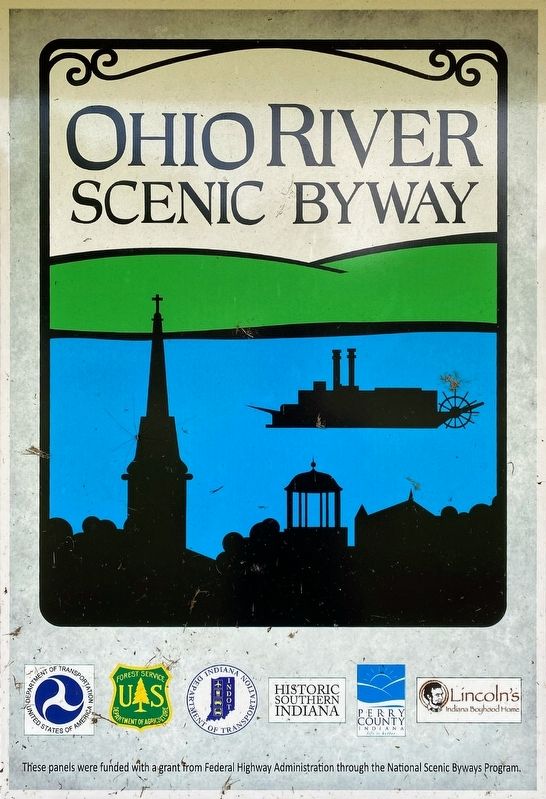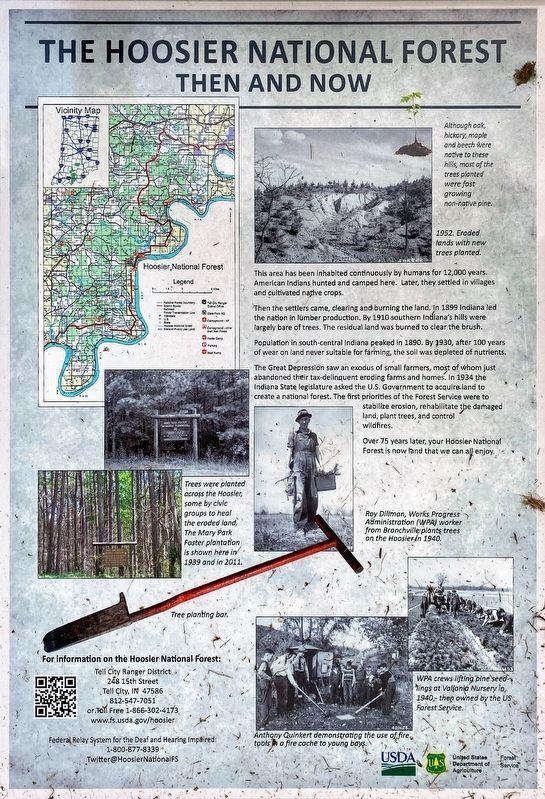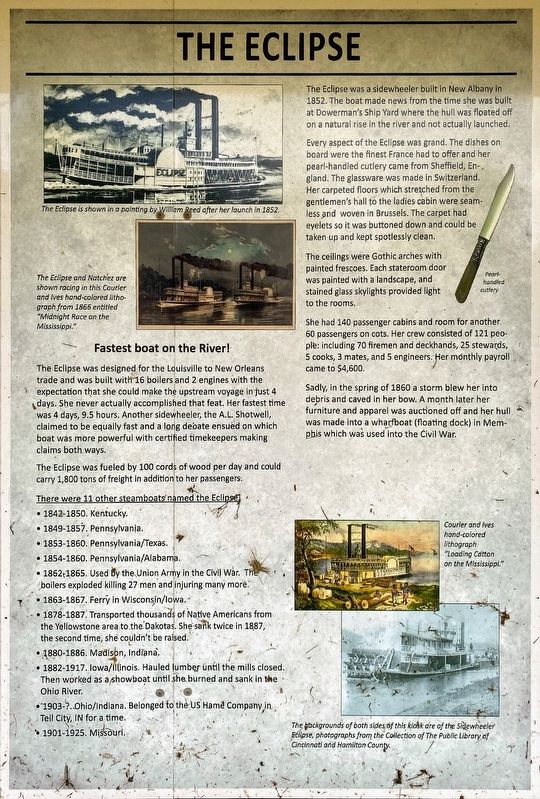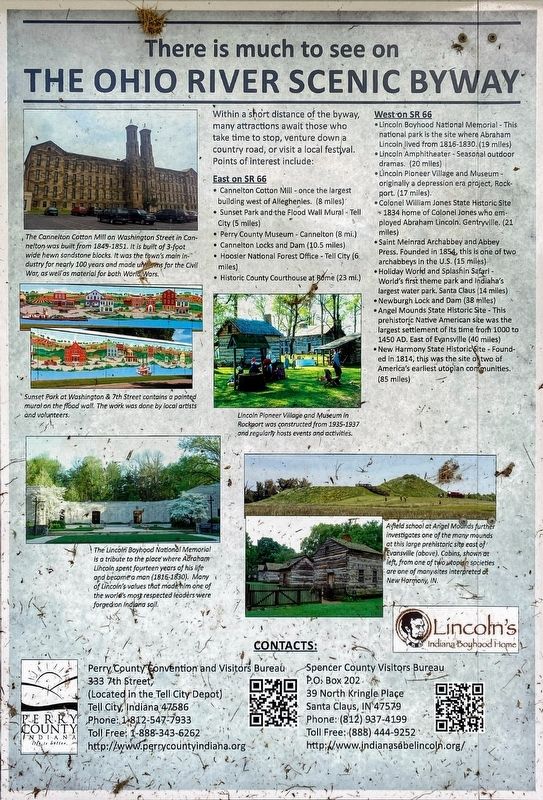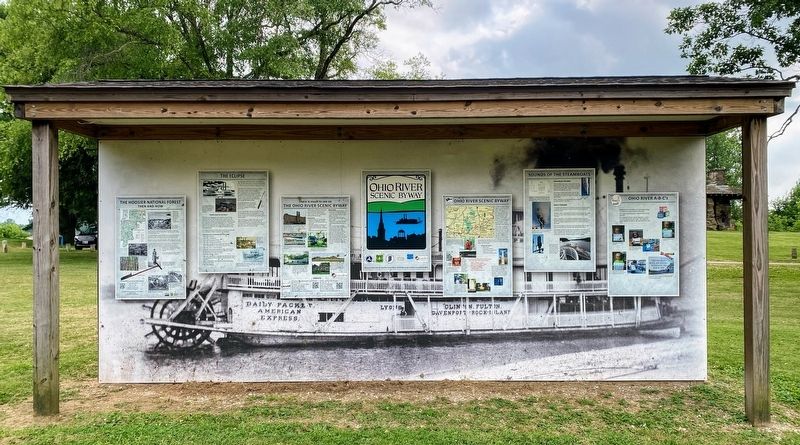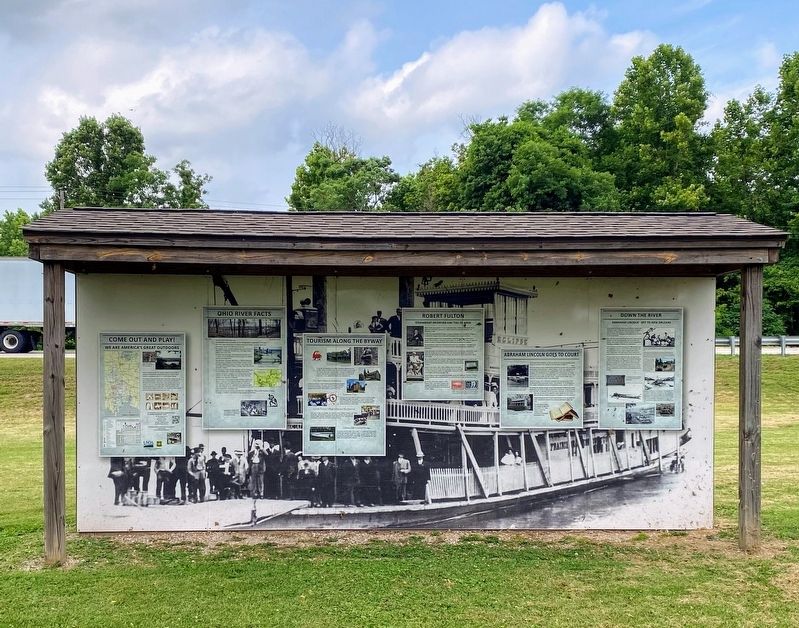Troy in Spencer County, Indiana — The American Midwest (Great Lakes)
Ohio River Scenic Byway
These markers were funded with a grant from Federal Highway Administration through the National Scenic Byways Program.
The the settlers came, clearing and burning the land. In 1899 Indiana led the nation in lumber production. By 1910 southern Indiana's hills were largely bare of trees. The residual land was burned to clear the brush. Population in south-central Indiana peaked in 1890. By 1930, after 100 years of wear on land never suitable for farming, the soil was depleted of nutrients.
The Great Depression saw an exodus of small farmers, most of whom just abandoned their tax-delinquent eroding farms and homes. In 1934 the Indiana State legislature asked the U.S. Government to acquire land to create a national forest. The first priorities of the Forest Service were to stabilize erosion, rehabilitate the damaged land, plant trees, and control wildfires.
Over 75 years later, your Hoosier National Forest is now land that we can all enjoy.
[Captions:]
Although oak, hickory, maple and beech were native to these hills, most of the trees planted were fast growing non-native pine.
1952. Eroded lands with new trees planted.
Roy Dillman, Works Progress Administration (WPA) worker from Branchville plants trees on the Hoosier in 1940.
Trees were planted across the Hoosier, some by civic groups to heal the eroded land. The Mary Park Foster plantation is shown here in 1989 and in 2011.
Tree planting bar.
WPA crews lifting pine seedlings at Vallonia Nursery in 1940 - then owned by the US Forest Service.
Anthony Quinkert demonstrating the use of fire tools in a fire cache to young boys.
The Eclipse
The Eclipse was a sidewheeler built in New Albany in 1852. The boat made news from the time she was built at Dowerman's Ship Yard where the hull was floated off on a natural rise in the river and not actually launched.
Every aspect of the Eclipse was grand. The dishes on board were the finest France had to offer and her pearl-handled cutlery came from Sheffield, England. The glassware was made in Switzerland. Her carpeted floors which stretched from the gentlemen's hall to the ladies cabin were seamless and woven in Brussels. The carpet had eyelets so it was buttoned down and could be taken up and kept spotlessly clean.
The ceilings were Gothic arches with painted frescoes. Each stateroom door was painted with a landscape, and stained glass skylights provided light to the rooms.
She had 140 passenger cabins and room for another 60 passengers on cots. Her crew consisted of 121 people: including 70 firemen and deckhands, 25 stewards, 5 cooks, 3 mates, and 5 engineers. Her monthly payroll came to $4,600.
Sadly, in the spring of 1850 a storm blew her into debris and caved in her bow. A month later her furniture and apparel was auctioned off and her hull was made into a wharfboat (floating dock) in Memphis which was used into the Civil War.
Fastest boat on the River!
The Eclipse was designed for the Louisville to New Orleans trade and was built with 16 boilers and 2 engines with the expectation that she could make the upstream voyage in just 4 days. She never actually accomplished that feat. Her fastest time was 4 days, 9.5 hours. Another sidewheeler, the A.L. Shotwell, claimed to be equally fast and a long debate ensued on which boat was more powerful with certified timekeepers making claims both ways.
The Eclipse was fueled by 100 cords of wood per day and could carry 1,800 tons of freight in addition to her passengers.
There were 11 other steamboats named the Eclipse:
1842-1850. Kentucky.
1849-1857. Pennsylvania.
1853-1860. Pennsylvania/Texas.
1854-1860. Pennsylvania/Alabama.
1862-1865. Used by the Union Army in the Civil War. The boilers exploded killing 27 men and injuring many more.
1863-1867. Ferry in WIsconsin/Iowa.
1878-1887. Transported thousands of Native Americans from the Yellowstone area to the Dakotas. She sank twice in 1887, the second time, she couldn't be raised.
1880-1886. Madison, Indiana.
1882-1917. Iowa/Illinois. Hauled lumber until the mills closed. Then worked as a showboat until she burned and sank in the Ohio River.
1903-?. Ohio/Indiana. Belonged to the US Hame Company in Tell City, IN for a time.
1901-1925. Missouri.
[Captions:]
The Eclipse is shown in a painting by William Reed after her launch in 1852.
The Eclipse and Natchez are shown racing in the Courier and Ives hand-colored lithograph from 1866 entitled "Midnight Race on the Mississippi."
Pearl-handled cutlery.
Courier and Ives hand-colored lithograph "Loading Cotton on the Mississippi."
The backgrounds of both sides of this kiosk are of the Sidewheeler Eclipse, photographs from the Collection of the Public Library of Cincinnati and Hamilton County.
There is much to see on The Ohio River Scenic Byway
Within a short distance of the byway, many attractions await those who take time to stop, venture down a country road, or visit a local festival. Points of interest include:
East on SR 66
Cannelton cotton Mill - once the largest building west of Alleghenies. (8 miles)
Sunset Park and the Flood Wall Mural - Tell City (5 miles)
Perry County Museum - Cannelton (8 mi.)
Cannelton Locks and Dam (10.5 miles)
Hoosier National Forest Office - Tell City (6 miles)
Historic County Courthouse at Rome (23 mi.)
West on SR 66
Lincoln Boyhood National Memorial - This national park is the site where Abraham Lincoln lived from 1816-1830. (19 miles)
Lincoln Amphitheater - Seasonal outdoor dramas. (20 miles)
Lincoln Pioneer Village and Museum - originally a depression era project, Rockport. (17 miles).
Colonel Williams Jones State Historic Site - 1834 home of Colonel Jones who employed Abraham Lincoln. Gentryville. (21 miles)
Saint Meinrad Archabbey and Abbey Press. Founded in 1854, this is one of two archabbeys in the U.S. (15 miles)
Holiday World and Spalshin Safari-World's first theme park and Indiana's largest water park. Santa Claus (14 miles)
Newburgh Lock and Dam (38 miles)
Angel Mounds State Historic Site - This prehistoric Native American site was the largest settlement of its time from 1000 to 1450 AD. East of Evansville (40 miles)
New Harmony State Historic Site - Founded in 1814, this was the site of two of America's earliest utopian communities. (85 miles)
[Captions:]
The Cannelton Cotton Mill on Washington Street in Cannelton was built from 1849-1851. It is built of 3-foot wide hewn sandstone blocks. It was the town's main industry for nearly 100 years and made uniforms for the Civil War, as well as material for both World Wars.
Sunset Park at Washington & 7th Street contains a painted mural on the flood wall. The work was done by local artists and volunteers.
Lincoln Pioneer Village and Museum in Rockport was constructed from 1935-1937 and regularly hosts events and activities.
The Lincoln Boyhood National Memorial is a tribute to the place where Abraham Lincoln spent fourteen years of his life and became a man (1816-1830). Many of Lincoln's values that made him one of the world's most respected leaders were forged on Indiana soil.
A field school at Angel Mounds further investigates one of the many mounds at this large prehistoric site east of Evansville (above). Cabins, show at left, from one of two utopian societies are one of many sites interpreted at New Harmony, IN.
Ohio River Scenic Byway
The National Scenic Byways Program is overseen by the Federal Highway Administration. The program is a grass-roots collaborative effort established to help recognize, preserve, and enhance selected roads throughout the nation. Roads are selected based on archaeological, recreational, cultural, historic, natural, and scenic qualities.
Every stop has a story to tell. This 967-mile byway follows the twists and turns of the Ohio River through Ohio, Indiana, and Illinois and offers attractions for sightseers. It is steeped in natural and cultural history. For most of its route the byway hugs the Ohio River shoreline and offers views of the river. The history of the River is found in rural landscapes and quaint river communities.
Unwind and Explore......
River Towns
The Great Outdoors
Famous People and Places
History and Folklore
Culture and Entertainment
For more information on the Indiana Section of the Ohio River Scenic Byway contact:
Historic Southern Indiana - University of Southern Indiana
8600 University Boulevard, Evansville, IN 47712
1-800-489-4474
http://ohioriverbyway.com
[Captions:]
The Hoosier National Forest has several campgrounds near the byway and Tipsaw Lake beach offers a cool respite in summer months. There are over 265 miles of trail ot hike, and trails are open to mountain bikes and horses.
Tell City, a town known for pretzels and chairs, was named for William Tell. Settled by the Swiss, a statue of William stands in front of Town Hall.
The gilded ballroom chair shown here is one of 425 custom-ordered by the White House from Tell City Chair Company in 1962.
At Lincoln's Boyhood Home National Park visitors assist re-enactors with daily chores. Visit the grave of Lincoln's mother and the 1834 home of Lincoln's first employer, Colonel William Jones.
Christ of the Ohio is an 18-foot tall statue near Troy, IN. Located on Fulton Hill, overlooking the Ohio River, the statue was commissioned by Dr. Nicholas James and sculpted by Herbert Jogurst, a German WWII prisoner of war held in Kentucky. Completed in 1956, the statue is meant to inspire river travelers.
Sounds of the Steamboats
Steamboat Whistles
The first steamboat to have a steam whistle was the Revenue, built in 1844. Within a few years, every boat had whistles. Though radios have replaced whistles to relay boat communications, whistles are still used as official passing signals on the rivers.
The sound of whistles varies widely. There are high tones, single note sounds; deep, sonorous 3-chimes; combinations of usually three single-tone whistles; and other variants.
When a boat sank or was decommissioned, its whistle was often passed to a new boat.
Steam Calliopes
The calliope was named for the muse for beautiful sound from Greek mythology. The instrument is loud, and many enjoy its quaint old-fashioned sound.
Patented in 1855, it was designed for use in a church, but was soon picked up by circus troops. Circus people pronounce the instrument's name "kally-ope."
It wasn't long before it was adopted by floating showboats along the Mississippi and then by river boats. On the river it's pronounced "kal-eye-o-pee". The calliope outperformed bands if for no other reason than it was louder!
Many of the calliopes on river boats found today were built by Thomas J. Nichol of Cincinnati, Ohio in the late 19th and early 20th century.
Older people who grew up along the river remember a time when the sound of calliope music playing meant a big boat was coming to dock. The music carried for miles, and as kids, they'd run to greet the boat and maybe make some tips helping passengers with their luggage.
[Captions:]
Belle of Louisville steam whistle.
Steamboat whistles became popular after 1844 and were unique to each boat and provided a "voice" to the individual craft.
The steam whistle from one of 12 steamboats called the Natchez (above) and from the Mississippi Queen below.
Steam escapes from the calliope pipes on the American Queen as the music rings out. The piano-like instrument is played on deck 5, while its pipes are off deck 6. (Right)
Ohio River A-B-C's
Make your own Ohio River A-B-C Book about things or places you've seen along the Ohio River.
Each page should represent a different letter of the alphabet.
Use magazine pictures, take photographs, or draw your own picture for each letter. The staple the pages together to make an ABC book about the Ohio River.
[Captions:]
A is for Angel Mounds near Evansville.
B is for Barge or Boat - Posing next to the steamboat on the mural wall at Tell City.
C is for Clifty Falls State Park or Coal, which is mined along the river and carried by barges.
H is for the Hillforest Mansion in Aurora, IN.
As you work on your book, you'll learn about the Ohio River and its history.
Come Out and Play! - We are America's Great Outdoors
Within 50 miles of here, the Hoosier National Forest offers a variety of recreational opportunities on your public lands. Camp in a developed site or in a more remote setting.
The Hoosier National Forest offers 260 miles of trails for hikers and backpackers. Most trails are also open for mountain biking and horseback riding. Boat access points allow you to canoe or boat our rivers and lakes, and many people enjoy fishing and hunting on public land. There are historic and natural sites to explore and birds and wildlife to watch. Bring your binoculars and camera and come see
[Captions:]
Views from Buzzard Roost, just off the Ohio River Scenic Byway.
Hoosier National Forest Recreation Sites.
Ohio River Facts
The Ohio River is 981 miles long.
The Ohio River touches six states, and its drainage basin includes parts of 14 states. The river's name comes from the Seneca (Iroquoian) ohiyo', meaning "good river."
The average depth of the Ohio River is 24 feet.
The Allegheny River and Monongahela River join to form the Ohio River at Pittsburgh, Pennsylvania - the largest metropolitan area on the river.
The Ohio River converges with the Mississippi River at Cairo, Illinois. At the confluence, the Ohio is larger (by volume) than the Mississippi River.
The Ohio River had great significance to Native Americans, and numerous civilizations formed along its valley. Prior to European settlement, Native Americans had major earthwork mounds in the Ohio Valley, including Angel Mounds near Evansville, Indiana.
For thousands of years, the river has been used for a transportation and trading route. Its waters connected communities.
Paducah, Kentucky is located at the northernmost ice-free reach of the Ohio River. before locks and dams, the river typically froze upstream of Paducah.
The Ohio River is the southern border of Ohio, Indiana, and Illinois. It was part of the border between free states and slave states in the years before the Civil War. The expression "sold down the river" originated from Kentucky slaves who were shipped via the Ohio and Mississippi to cotton and sugar plantations in the Deep South.
Before and during the Civil War, the Ohio River was called the "River Jordan" by slaves crossing it to escape to freedom in the North via the Underground Railroad.
[Captions:]
View from Buzzard Roost.
The head of the Ohio River in Pittsburgh where the Allegheny and Monongahela Rivers join.
Engraving from William Still's "The Underground Railroad" and the Running Man symbol of the Underground Railroad.
Tourism Along the Byway
If you like the outdoors and history, southern Indiana has a lot to offer. There are public lands, forests and historic sites just off the byway. Small town festivals offer a variety of activities and cultural experiences throughout the year. Most are free and include food, music, educational booths, and interactive fun.
The Saint Meinrad Archabbey
Above the small town of Saint Meinrad is one of only two archabbeys in the US, one of seven in the world. The monks operate a graduate-level School of Theology and offer guided tours. The grounds are beautiful and the historic 1854 cathedral is well worth a visit.
Schweizer Fest
Held every year since 1958 to celebrate the town's Swiss heritage. The festival includes a wine garden, an archery contest (brings visions of William Tell to mind), koffee klatch, and fitness competitions. Come join the descendants of the original Swiss settlers and have some fun in early August.
Lincoln Pioneer Village & Museum Rendezvous
Each year in May and October, the Rockport Lincoln Pioneer Museum and Village comes alive. Demonstrations include: chair caning, spinning, weaving, open fire cooking, needle working, blacksmiths, candle making for kids, hawk and knife competitions, music, food, and more. Come join the fun.
Huffman Mill Covered Bridge
This historic covered bridge, built in 1864, is a modified Burr Arch design, 150-feet long spanning the Anderson River on county Road 1490 North. Built entirely of yellow poplar, the bridge connects Spencer and Perry Counties and once served the Huffman Mill. It is now bypassed by a new bridge, and only foot traffic is allowed.
[Caption:]
Historic Nester House in Troy, IN
Robert Fulton - Steamboat Inventor Has Ties to Area
Robert Fulton was a genius. He was a successful artist, scientist, and engineer. He designed one of the first submarines in 1801, and the first practical steamboat, the Clermont, in 1807.
In 1811, the Steamboat New Orleans, designed by Robert Fulton and Robert Livingston made the first voyage down the Ohio and Mississippi to New Orleans and back.
Foreseeing the impact of river transportation, Fulton traveled down the Ohio River around 1805 looking for investment opportunities. He visited the Troy area and began the process to obtain a land grant patent for the area from President James Madison.
The land grant for 1,040 acres included the area from Troy to Cannelton. It included a coal mine and potential wood yard, two resources Robert anticipated being in demand by steamboats.
Fulton persuaded his brother Abraham to leave his job, move to Troy, establish the wood yard and manage the coal mine. Abraham was also to build a house on a scenic hill above the town of Troy, still known as Fulton Hill, where the "Christ of the Ohio" statue now stands.
But in 1813, Abraham was killed by a falling log while building a log house. He was the first person buried in the Troy Cemetery. After Abraham's tragic death, Robert returned with Abraham's family to Pittsburgh, abandoning his plans.
Robert Fulton died in 1815. While walking home on the frozen Hudson River one of his friends fell through the ice. In rescuing his friend, Fulton got soaked and later caught pneumonia, then consumption, and died at the age of 49.
Robert Fulton has been honored by US postage stamps and sculptures. Counties in Indiana, Illinois, Kentucky, Ohio, and Pennsylvania are named for him as well as many towns and streets.
But for an unfortunate tragedy in 1813, Robert Fulton, the brilliant inventor who changed the world, once planned to live here, along the Ohio River above the town of Troy, Indiana.
[Captions:]
Robert Fulton - 11/14/1765 - 2/14/1815
Sculpture of Robert Fulton in the U.S. Capitol.
Abraham's grave in Troy.
In 1909, a 2-cent stamp celebrates steamship technology. In 1965, a stamp commemorating the bicentennial birthday of the inventor of the first successful commercial steamship.
Abraham Lincoln Goes to Court
James Taylor hired Abraham Lincoln to operate his ferry, transporting people across the Anderson River during the fall and winter of 1826-1827.
That next spring, Lincoln started taking people out to catch rides on passing steamboats. He kept his boat at Bates Landing. Lincoln was a strong young man and with one pull of the oars could propel a boat over 100 feet. he charged 6.25 cents/person for a round trip. Two businessmen who asked to be rowed out to catch a steamboat were so impressed with Lincoln they paid him an entire dollar. He later wrote, "I could scarcely credit, that I, a poor boy, had earned a dollar in less than a day."
Later that spring, John T. Dill and his brother, who operated a ferry from the Kentucky shore confronted Lincoln. They accused him of infringing on their legally established business and operating a ferry without a license.
To address the charges brought by the Commonwealth of Kentucky, Lincoln appeared in the home of Judge Samuel Pate in Hawesville, Kentucky where court was held. He admitted that he had taken passengers to the middle of the river, but had not transported anyone across the river. Therefore, he had not needed a license or infringed on the Dill's business.
Judge Pate agreed with Lincoln's interpretation of the law which forbade unauthorized persons from carrying passengers "over" the river.
The case led to a friendship between Judge Pate and Lincoln. The Judge loaned Lincoln law books to study which likely encouraged his interest in law.
[Captions:]
Picture of a simple ferry such as Lincoln may have operated for James Taylor.
The former home of Hancock County Judge Samuel Pate still stands today.
Down The River - Abraham Lincoln - Off to New Orleans
It was 1828 and James Gentry had a flatboat loaded with produce to sent 1,200 miles down the Ohio and Mississippi Rivers to New Orleans. He was sending his son Allen, but hired the strapping young neighbor boy, Abraham Lincoln to go along.
Their job was to see that the goods made it safely to New Orleans, sell the boat and goods, and return with the money. Gentry paid Lincoln $24 for the job and gave the boys return passage to Indiana on a steamboat.
The trip made quite the impression on the teenage boys. The adventure marked Lincoln's first visit to a major city and exposed him to the nation's largest slave market. Allen Gentry later said watching the slave auctions disturbed Lincoln and remained with him the rest of his life.
The trip nearly cost the boys their lives, one night while moored south of Baton Rouge, in the Louisiana plantation country, their flatboat was attacked by seven men. That trip, and a second one in 1831, where he built his own flatboat, would be the two longest journeys of Lincoln's life. They were his only visits to the Deep South, and his primary experiences with a racially and culturally diverse people.
[Captions:]
Though this historical lithograph shows five young men piloting a flatboat, Abraham Lincoln and Allen Gentry piloted their boat with just the two of them.
In 2008, re-enactors took a replace of the 60 foot long, 25 ton boat down the river to recreate the voyage for Lincoln's 200th birthday. However the replica boat, (shown below, in Memphis, TN) included two engines. The re-enactors said they were unable to pilot the boat without the engines. However the attempt gave them a greater appreciation of life in those days.
"You can't do it," one man said, "It's almost impossible. We had two people on either end of the oar and two people on the rudder, and we could hardly move it. And remember, there were only two of them. People back in those days were a lot stronger. I wouldn't want to try and whoop one of them."
A flatboat, also known as a broadhorn, had a steering oar (or "sweep") at the stern, side sweeps or poles, and often a short bow oar (also called a "gouger") for keeping the boat in the current. They generally drifted downstream with the current and were poorly suited to upstream travel. A wood shelter covered the boat, shielding both crew and cargo from the elements. Below a boy pilots a small flatboat on a river.
This historical marker in Rockport commemorates Lincoln's trip to New Orleans.
Flatboats at dock on the Mississippi River in New Orleans (above) and at right, a carefree day on the river.
Erected by U.S. Department of Transportation; Forest Service, U.S. Department of Agriculture; Indiana Department of Transportation; Historic Southern Indiana; Perry County, Indiana; Lincoln's Indiana Boyhood Home.
Topics. This historical marker is listed in these topic lists: Industry & Commerce • Parks & Recreational Areas • Waterways & Vessels. A significant historical year for this entry is 1899.
Location. 37° 59.985′ N, 86° 48.849′ W. Marker is in Troy, Indiana, in Spencer County. Marker is on Indiana Route 66 just east of County Road 1290E, on the right when traveling east. The marker stands on the grounds of Lincoln Ferry Park, and can be accessed through a small driveway which leads to a parking lot at the park. Touch for map. Marker is in this post office area: Troy IN 47588, United States of America. Touch for directions.
Other nearby markers. At least 8 other markers are within 5 miles of this marker, measured as the crow flies. A New Home in Indiana (within shouting distance of this marker); Abraham Lincoln Employed (within shouting distance of this marker); Abraham S. Fulton (approx. 0.6 miles away); Riverplace (approx. 0.6 miles away); Lincoln Acquitted (approx. 3.1 miles away in Kentucky); Veterans Memorial (approx. 3.1 miles away); Army and Air National Guard Veterans Memorial (approx. 4.1 miles away); Perry County Indiana Honor Roll Memorial (approx. 4.1 miles away). Touch for a list and map of all markers in Troy.
Credits. This page was last revised on October 23, 2021. It was originally submitted on July 29, 2021, by Shane Oliver of Richmond, Virginia. This page has been viewed 296 times since then and 21 times this year. Photos: 1, 2, 3, 4, 5, 6. submitted on July 29, 2021, by Shane Oliver of Richmond, Virginia. • Devry Becker Jones was the editor who published this page.
